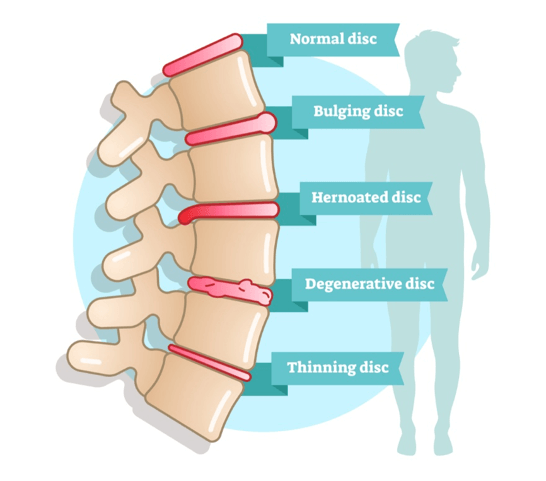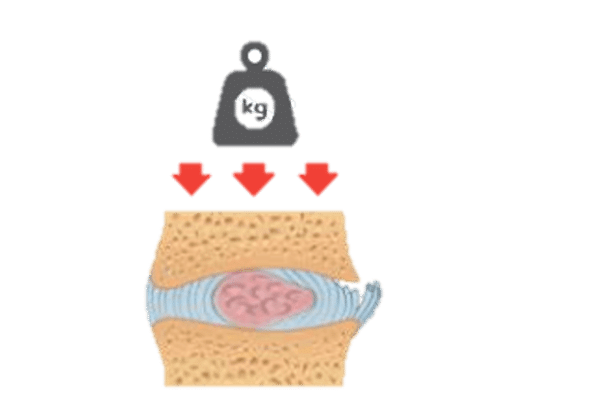Request Appointment
Enter your details and we will be in touch with you shortly;
Or call 08655885566 between 8 am and 8 pm.

Damage to the intervertebral (spinal) disc that causes it to bulge out of its alignment

The gel-like substance inside the vertebrae that absorbs any shock from impact loses its shape and position, leading to disc bulge. 35% of back-pain patients suffer from disc-bulge or disc degeneration and most of them are affected in the lower back. Read more about back and neck conditions among adolescents and young adults here.
A bulging disc might not cause any pain or give any symptom as it may not have reached a certain severity level and this might make it difficult to identify the condition before it shows up any symptom. However, when the disc gets pressed against a spinal nerve root, one may experience symptoms like pain, tingling, numbness, or muscle weakness. The symptoms of bulging discs vary according to the severity of the bulge and the affected level of your spine.
Get immediate medical care if:
If there’s sciatica or a pinched nerve in the spine, it will interfere with your daily functioning.
 Professional diagnosis required
Professional diagnosis required Chronic, can last for years
Chronic, can last for years Treatable with 4 weeks of QI Spine Therapy
Treatable with 4 weeks of QI Spine TherapyMany different factors cause disc bulge but the most common conditions that lead to bulging discs are as follows:
 Professional diagnosis required
Professional diagnosis required Chronic, can last for years
Chronic, can last for years Treatable with 4 weeks of QI Spine Therapy
Treatable with 4 weeks of QI Spine TherapyIf disc bulge isn’t treated on time, it can lead to disc herniation (commonly known as slipped disc). The treatment is often based on the patient’s age and the severity of the condition:
This step is only taken if the pain cannot be managed in 6-8 weeks and the condition is intolerable for the patient. Most cases can be managed with conservative treatment methods only and only about 5% of cases require surgery.
Diagnosing and treating bulging discs on time is essential. If disc bulge is not treated on time, then it may lead to disc herniation. The treatment is often based on the age of the patient and the severity of the condition.
Bulging disc treatment mainly consists of spine rehabilitation by isolating the inefficient muscles of the spine. With the help of DSA, weaker muscles are identified, isolated, and treated. This approach not only reduces the pain but also strengthens the weaker muscles.
Qi Spine also offers a cell repair technology for bulging disc treatment wherein Frequency specific microcurrents are administered to the patient. It reduces pain, inflammation, and also speeds up the healing process.
You can follow the below tips to prevent a bulging disc:
A bulging disc itself can lead to other complications; the most common one is spinal stenosis. Spinal stenosis happens when a bulging or herniated disc pinches the spinal cord which can lead to temporary or permanent paralysis.
So, if you experience numbness in the groin area or your feet or incontinence, then you must seek immediate medical help. If these symptoms are left ignored, it can lead to irreversible nerve damage.
Visit a doctor if your pain doesn’t improve with medications, neck or back pain is radiating down your arm/leg, or if you have numbness, tingling or weakness, or difficulty in controlling bowel/bladder movement.
 Professional diagnosis required
Professional diagnosis required Chronic, can last for years
Chronic, can last for years Treatable with 4 weeks of QI Spine Therapy
Treatable with 4 weeks of QI Spine TherapyIf disc bulge isn’t treated on time, it can lead to disc herniation (commonly known as slipped disc). The treatment is often based on the patient’s age and the severity of the condition:
 Professional diagnosis required
Professional diagnosis required Chronic, can last for years
Chronic, can last for years Treatable with 4 weeks of QI Spine Therapy
Treatable with 4 weeks of QI Spine TherapyThe bulging disc symptoms can mimic other conditions of the spine. Hence, obtaining an accurate diagnosis is important. Your physician will go through your medical history and check for your symptoms along with physical examination.
Your doctor may advise you to get a few imaging tests like:
The spine specialist will go through your previous medical records, conduct a physical examination and check for your symptoms. A neurological examination might be done to check your reflexes, muscle strength, ability to walk, and ability to feel.
If required, you may be asked to get a few imaging tests like X-ray, CT scan, and MRI scan to check which nerves have got affected. Digital Spine Analysis test may also be advised to check the muscles around the spine which might have gone into inefficiency hence leading to a bulging disc.
 Professional diagnosis required
Professional diagnosis required Chronic, can last for years
Chronic, can last for years Treatable with 4 weeks of QI Spine Therapy
Treatable with 4 weeks of QI Spine Therapy






Have a question?
Ask our spine specialists
Who is a QI Spine Specialist?
A QI Spine Specialist is a medical expert with

Dr. Nidhi Sanghvi Shah

Dr. Manisha Moorjani

Dr. Shital Gaikwad

Dr. Richa Bhatia
9000 hours
of specialisation in treating back and neck conditions
32 hours
of spine physiotherapy specialisation methods in McKenzie concepts, Kinetic control, Neurodynamic solutions, Mulligan’s concepts
500 hours
and 6 months of QI Spine specialisation courses
No, a bulging disc is not the same as a herniated disc.
When the disc sags and looks like it’s protruding outwards, but the outer covering of the disc remains intact, it is called a bulging disc. Whereas when the outer covering of the disc experiences a tear due to which the inner fluid oozes out into the spinal canal, it is called a herniated disc. A herniated disc is an increased level of severity of a disc bulge.
Generally, bulging discs are age-related degeneration. The discs deteriorate as we age and bulge downward. It develops over time. A bulging disc occurs when a disc suffers some damage and is pushed outward from its position extending beyond the vertebrae.
Basically, pain management and physical therapy are the two ideal non-surgical, non-invasive bulging disc treatment options.
Yes, it is true. A herniated disc may actually begin with a bulging disc whose outer wall has been ruptured.
You must visit a spine specialist if you start experiencing the following signs: